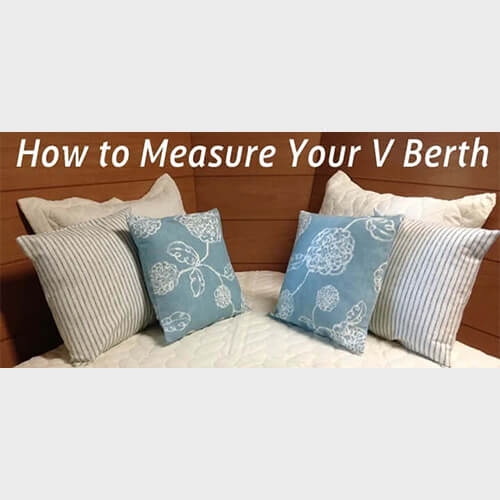Making V Berth bedding products is challenging but can be very rewarding. The best part is you can use any fabric you choose to make your products. Want to go bright teal? You can! The first step to make your own V Berth topper, sheet, comforter, etc requires that you know how to properly measure your v berth. With our Universal CinchFit Fitted Sheet design, we get it right without needing a template, but for those of you who do want to create your own, here’s how to properly measure your v berth.
While most v berths have essentially the same basic shape (hence the name v berth), the measurements can vary greatly from boat to boat. The key to measuring and cutting raw materials to fit your v berth is to get the angles correct. Here are the important measurements and steps to successfully do this.
Traditional V Berth Shape – Symmetrical
If you are making a product that fits on top of your v berth – such as a quilt, topper, etc., then the two measurements you’ll need to determine the total amount of material needed are:
- The width of the Head (H)
- The length between the Foot and the Head (Center)
(Note: If you are making a fitted product such as a fitted sheet, you will also need to add additional length to all measurements to account for both mattress depth and seam allowances.)
Step 1: Measure the Head Width. Divide this number in half.
Step 2: Measure the Total Length between the Foot and Head.
Step 3: Measure the Foot Width. Divide this number in half.
Step 4: Lay out your raw material in a large open space.
Step 5: Measure the material to determine which side is long enough to be used for the Head and which side is long enough to be used for the Total Length of your material. Place the material so that the Head side of the material is facing you.
Step 6: Mark the exact center of the material at the Head end with fabric chalk (Head – Center). Mark the exact center of the material at the Foot end with fabric chalk (Foot – Center).
Step 7: Using the measurement you calculated in Step 1 (1/2 Head Width), measure from the Head Center to the left the number of inches you calculated as half the Head Width and mark this spot (Head – Left). Measure from the center to the right the number of inches you calculated as half of the Head Width and mark this spot (Head – Right).
Step 8: Using the measurement you calculated in Step 2 (Total Length) measure from the Head Center towards the Foot end the number of inches you calculated as Total Length and mark this spot. (Foot Center/Total Length) Trim material if needed so material is the correct Total Length.
Step 9: Facing the Foot End of the material and using the measurement you calculated in Step 3 (1/2 Foot Width) measure from the Foot Center to the left the number of inches you calculated as half of the Foot Width. (Foot – Right) Measure from the Foot Center out to the right the number of inches you calculated as half the Foot Width and mark this spot. (Foot – Left)
Step 10: To achieve the exact, correct angle for your raw material just connect the (Head Left) to the (Foot Left) using a ruler, board, straight edge. Then connect the (Head Right) to the (Foot Right).
(Note: If you are using fabric, the same process can be more easily accomplished by folding the fabric in half at the center points and then measuring points, connecting points and then cutting two layers of fabric at the same time.)
Asymmetrical or Rounded V Berth Shapes
Although more difficult, these shapes can be measured accurately.
Step 1: Measure Total Length.
Step 2: Measure Head Width.
Step 3: Measure Foot Width.
Step 4: Measure the Length of all Sides (Side Lengths).
Step 5: For each Side Length, also measure the Total Width at that point.
Step 6: For each Side Length also measure the Length from the Foot where the Side Width changes.
Step 7: Lay out your fabric and mark your (Head Center) and (Foot Center).
Step 8: Measure the (Head Left), (Head Right), (Foot Left), and (Foot Right) as shown in the Traditional V Berth measuring instructions.
Step 9: Starting at the Foot, measure each Side Length and at the same time make sure that the total width is correct at that location using both the Side Width Measurement and the Length from the Foot measurements taken earlier.
Voila! Now you know how to properly measure your v berth so you can create a template for custom bedding makers, or so you can sew your own v berth bedding.
Don’t forget to check out our Universal CinchFit Fitted Sheets, which take the guesswork out of measuring for custom sheets, yet still fit your v berth cushions like a charm, and be sure to sign up for our newsletter so you don’t miss any of our tips, to get notified of upcoming sales, and to get special, subscriber-only coupons to use on our site.
Check out all of our boat bedding products at Quahog Bay Bedding HERE!
Here's just a sample of our best selling boat bedding products!







